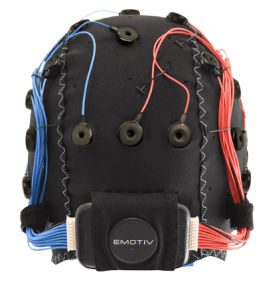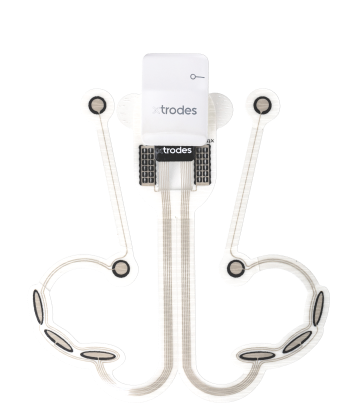If the last few years have taught us anything, it’s that change can happen at any time and affect us in significant ways. Whilst it’s not easy to see at times, each and every challenge we face means we are building our mental capacity by being more agile and resilient.
Opportunities to increase our mental capacity can occur through increased awareness and having the right tools available. By partnering with EMOTIV, you can create an individualized approach to mental resilience and agility. EMOTIV’s electroencephalograph (EEG) technology can do what we humans are notoriously bad at—assessing our own stress levels and cognitive limits, helping us improve our resilience.
Imagine being in a position where you were aware of all the things impacting your mental capacity. EMOTIV can help!
Mental agility
Understanding your stress levels and periods of focus can help you increase your resilience: knowing when to take a break while you’re working can help you reduce stress. In turn, this not only improves your resilience at work but also outside of work.
“The greatest glory in living lies not in never falling, but in rising every time we fall.” Nelson Mandela
How agile are you? Agility means your ability to adjust your mind to new circumstances, and quickly shift between a laser focus and the bigger picture. Examples of agility include:
- F1 teams who move and respond quickly to different conditions at races.
- Those responding to natural disasters—where significant coordination of effort is required by individuals in conjunction with government agencies, emergency services, and community based organizations.
- Responding to significant personal or business challenges during the pandemic, which required people to work from home and businesses to adapt to remain viable.
We need agility to thrive in the disruptive and somewhat unknown futures that we face.
Resilience
When faced with adversity, do you break or bounce back? If you accept that life is uncertain and through uncertainty, you will grow as an individual, this is a great start to building your resilience. By developing a resilient and all-around positive approach in your life, you will have the emotional strength and adapt to difficult situations.
How resilient are you?
Resilience is that quality that allows some people to be knocked down by life and come back stronger than ever. Rather than letting failure overcome them and drain their reserves, resilient people find a way to rise from the ashes.
Psychologists have identified some factors that make someone resilient: including a positive attitude, optimism, the ability to regulate emotions, and the ability to see failure as a form of helpful feedback. Despite the misfortune, resilient people are blessed with an outlook that enables them to change course and soldier on.
If you take time to reflect on your life so far, what would you consider is your level of resilience? The Resilence Shield, an approach outlined by very experienced SAS soldiers, indicates that you can assess your resilience across a number of areas, including Innate, Mind, Body, Social, Professional, and Adaptation layers.
You can understand your own resilience by taking the Resilience Shield survey. The results indicate areas of focus and change to build your resilience. For example, a low score in the social layer means you should invest more time with your family and friends.
Overall, it is good to recognize the great things you have done and then consider what you could do differently to build your resilience.
Resilience and Failure
In many of his books, Sir Richard Branson has indicated that how resilient people deal with failure sets apart successful people from everyone else. “Failure is one of the secrets to success since some of the best ideas arise from the ashes of a shuttered business,” he explains. The strongest entrepreneurs and leaders are the ones who have experienced a few failures and have proven their resilience in the face of adversity. “Resilience is one of the hallmarks of an entrepreneur who can stay in business in the long term,” Branson argues.
Build your resilience
There are numerous examples of individuals who are an inspiration in building resilience. Louis Zamperini was a World War II prisoner of war, an Olympic athlete, an inspirational figure, and writer. Born in January 1917 in Olean, New York, and raised in California, Zamperini joined the track team in high school. Excelling at long-distance events, Zamperini competed in the 1936 Berlin Olympics. He was ready to compete again in the 1940 Tokyo Olympics. However, World War II broke out, and the Games were canceled.
A bombardier in the Army Air Corps, Zamperini was in a plane that went down. When he arrived on shore in Japan 47 days later, he was taken as a prisoner of war and tortured for two years. After his release, Zamperini became an inspirational figure, and his life served as the basis for the 2014 biography Unbroken: A World War II Story of Survival, Resilience, and Redemption.
Another example of how extreme resilience is built into individuals is Australia’s Special Air Services Regiment (SASR). The regiment was established after World War II out of a need for smaller teams to work outside normal military operations. The characteristics of the SASR soldier remain unchanged: emotional and physical resilience and mental toughness. But what sets them apart is their extreme psychological resilience and their unique cognitive ability.
SASR soldiers are subject to the toughest, most gruelling selection process known. “In short we try and deconstruct a person down to their bare humanity,” By using techniques such as sleep deprivation and food deprivation you can really strip back a person and see their levels of resilience and levels of cognitive ability. The end result is a handpicked, highly homogenous group of soldiers trained to handle the most gruelling and complex military operations.
Build resilience with EMOTIV
Your brain is the most complex part of your body. Scientists have learned more about the brain in the last 10 years than in all previous centuries because of the accelerating pace of research and the availability of neurotechnology. EMOTIV’s technology can do what we all want to do — support you in increasing your resilience.
Using the inspiring examples quoted previously and EMOTIV’s EEG technology, you can build your own capability and resilience to adversity using a combination of physical and mental techniques. The following tips will support you on the journey:
- Develop an optimistic view of the world.
- Learn from the best about models of resilience.
- Consider that there is not one single path to success.
- Take time to think about all you have learned from a mistake or a failure.
- Going back to basics, test yourself emotionally and physically to build your capability.
- Ensure a well-rounded approach to life with balance in all areas.
- Build in your approach with EMOTIV.
EMOTIV’s technology empowers you to better understand your brain, giving an “insider’s view” of how your brain reacts to certain events during your day.
EMOTIV’s technology measures EEG data from the brain and analyzes it to derive insights about brain function, providing meaning to certain events and conditions. By harnessing the power of your brain with EMOTIV’s technology and brain insights, you can optimize your day and build resilience.
EMOTIV is a recognized pioneer and market leader in the field of BCI enterprise solutions and EEG technology. Its award-winning EMOTIV EPOC+ headset and the 10-year anniversary edition EPOC X provide professional-grade BCI data for academic research and commercial use.













